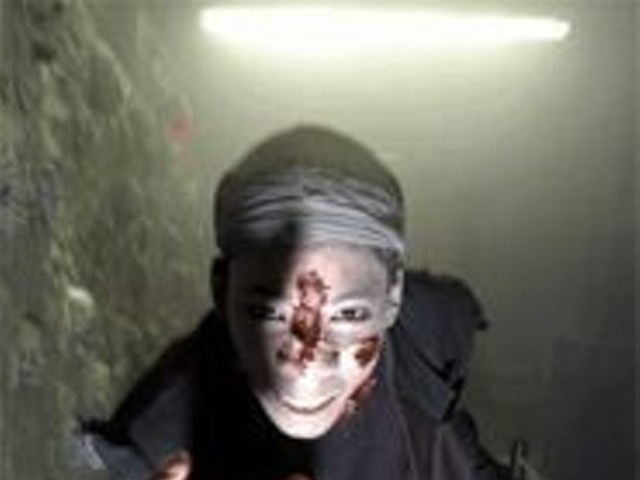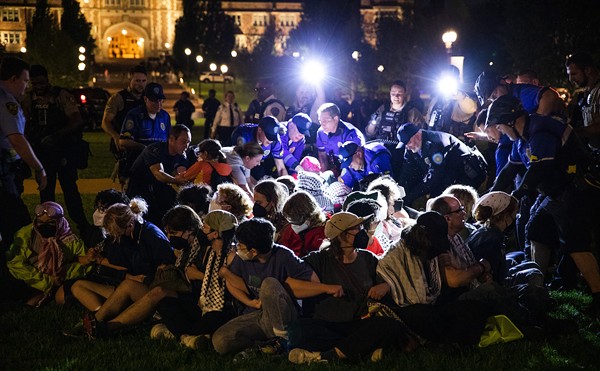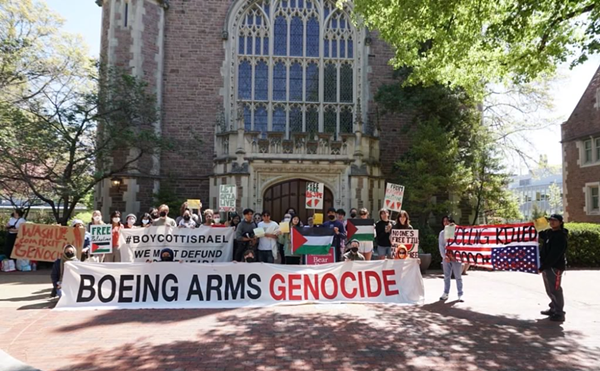The case challenges the constitutionality of SLU's inclusion in the Grand Center tax increment financing district, or TIF. Approved by the St. Louis Board of Alderman in 2002, the Grand Center TIF seeks to encourage development by rewarding developers with a portion of area property, sales and other taxes to help offset development costs. Projected to generate $80 million, the TIF has pledged $8 million towards the SLU arena.
"It's not that complicated an issue. The constitutional provision says that public funds should not go to a college or university that is under control of a religious creed," says James Stemmler, the Masons' attorney in the case. "Attorneys for Saint Louis University are trying to argue that the school is not under control of a religious creed."
Though the trial court originally rendered a summary judgment — without trial, that is — in SLU's favor, university opponents appealed, and the case has been quietly wending its way through the state court system ever since. Now, both sides are claiming victory from an October 3 appellate court ruling that transfers the case to the Missouri Supreme Court.
Writing for the majority, Judge Roy L. Richter found that "SLU, although a university with a Jesuit tradition, is not a university 'controlled by a religious creed,'" and therefore was not constitutionally barred from receiving TIF-generated monies.
Judge Richter added that although the appellate majority would find in favor of the university, "in light of the general interest and importance of the issues presented here" the case should be transferred to the Missouri Supreme Court.
"The University remains confident in its belief that the TIF ordinance supporting the arena is constitutional and that it will prevail in this case," says Director of University Media Relations Clayton Berry in a prepared statement.
Opponents of the university's inclusion in the Grand Center TIF are also taking heart, choosing to concentrate on the concurring opinion of Appellate Judge Lawrence E. Mooney.
In his strongly-worded critique of the majority opinion, Mooney writes: "Saint Louis University's by-laws provide that it shall be publicly identified as a Catholic and Jesuit university and shall be governed in accordance with that identity. I would infer from that, plainly, Saint Louis University is a Catholic university. "
Judge Mooney adds that the state Supreme Court has already provided a road map to direct the appellate court's decision: "[L]et us recall that the Missouri Supreme Court has already announced that '[t]he constitutional policy of our State has decreed the absolute separation of church and state, not only in governmental matters, but in educational ones as well. Public money, coming from taxpayers of every denomination, may not be used for the help of any religious sect in education or otherwise.'"
Critics add that aside from the constitutional question, SLU's involvement in the Grand Center TIF is also hampering redevelopment in the area. The original TIF ordinance proposed by Grand Center states that the arts district will put initial TIF funds toward several projects, including the SLU arena, an African-American Museum, the Metropolitan Building, the Woolworth Building and Olive West Housing.
Today, although the majority of the 26 projects included in the original ordinance were projected to have been completed before 2006, only a few have managed to reach fruition.
"This whole idea that these other projects were going to get off the ground right away: It's a bunch of hooey," says longtime Grand Center resident Frederick Medler, who notes that Saint Louis University President Lawrence Biondi also sits on Grand Center's Board of Directors. "It's not going to happen. The TIF has been structured in a specific way, and it's been done this way to benefit Saint Louis University."
A subsequent amendment to the TIF ordinance promised developers Series A, B, C and D notes, which developers could redeem for reimbursement upon project completion. But critics say there was a rub: Series A notes had to be honored first and in full before holders of the other notes can cash in.
"It's first dollar in, first dollar out. That's in the TIF," says an opponent of the university's inclusion in Grand Center's development scheme who declined to be identified. "It basically explains that they are going to satisfy the TIF obligations in Series A notes first. All other notes are subordinate to the A notes. Because they are all subordinate to the Series A note, no other project will get a penny until those notes have been paid."
Three projects were initially promised Series A notes when the note ordinance was approved: the SLU arena, the Woolworth Building and "district improvements." However, in February 2006 the ordinance was again amended, making the Saint Louis University arena the sole project in line for Series A notes. Critics contend that, in other words, the SLU arena project must first receive its entire $8 million from the Grand Center TIF before any other projects in Grand Center will become eligible to receive TIF funding.
Not so, says Grand Center President Vincent Schoemehl, who disputes the claim that the SLU arena is adversely affecting the rate of development in the arts district. "There's a whole group of projects that is moving forward," says Schoemehl. "The Metropolitan Building, the Woolworth Building, the Centene Center for the Arts: Calling something Series A does not describe its priority in terms of financing. It simply describes sources for some of the funding for it. All of those projects are moving forward."
Nonetheless, development appears to be stalling in the often deserted Grand Center. Developer Steve Trampe recently announced that his firm, Owen Development, was pulling out of the $10 million renovation of the Woolworth Building. Similarly, principals at the Pyramid Companies have placed their $27 million development plans for the Metropolitan Building on hold while the company concentrates on other projects such as its renovation of downtown's Saint Louis Centre.
Trampe did not respond to numerous requests to comment for this story. However, an article in the October 6-12 edition of the St. Louis Business Journal quoted Trampe as saying: "These are really tough buildings (to develop). You can't say retail or office or residential has been proven to this point in Grand Center. Almost any use, except entertainment, is still very much pioneering."
Grand Center resident Medler says he has a simple solution to make the arts district's buildings more attractive to developers: "SLU should remove itself from the TIF so that Grand Center can get on with its own development," says Medler, who is a party to the lawsuit.
"SLU has more money than they know what to do with. They're going to get nearly all the generated TIF funds for the next seven or eight years, and there's not going to be any money available for anything else in the neighborhood," adds Medler. "The university has a huge endowment. They don't need our money. Besides, this arena is half a mile south of Grand Center. Its construction really doesn't benefit Grand Center."
Like many universities, Saint Louis University is a nonprofit entity and does not have to pay property taxes on buildings that it owns. Nonetheless, SLU representatives are quick to point out that the institution has invested an estimated $500 million in the city's once blighted Midtown neighborhood.
SLU representatives add that the arena, whose estimated cost is $80.5 million, will only enhance the area. "The Saint Louis University arena will bring hundreds of thousands of people to Midtown St. Louis each year and will significantly enhance student life and will be an economic and social asset [to] the entire St. Louis community," says university spokesman Berry in a written statement.
Adds Schoemehl: "The bottom line is that we think the lawsuit is unfounded. It was unnecessary, and we think Saint Louis University, the City of St. Louis and Grand Center are going to prevail. It was a mean-spirited nuisance lawsuit that should never have been filed."
But critics maintain the lawsuit highlights serious constitutional and municipal concerns, adding that SLU's past investment in the area does not allow the university to tap public funds.
"Go down any major hallway on that campus and you'll find a crucifix. You won't find a star of David or a Koran on display," says Medler. "If [Saint Louis University President Lawrence] Biondi really believes that he deserves this public money, then he needs to come out and proclaim publicly to all of St. Louis that Saint Louis University is no longer a Catholic university. Then he can have his TIF money."





